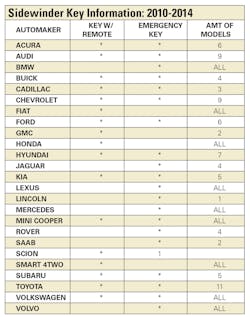Mercedes started the ball rolling with their first generation of sidewinder keys in 1979. BMW followed a few years later with a different sidewinder key version. With the exception of a few non-conformists such as Chrysler, Infiniti and Mitsubishi, every major automotive manufacturer selling cars in the North American market today is using sidewinder-type keys on at least a portion of their fleet of cars.
Another wrinkle was added in 1995 when electronic security was added to automotive keybows and the new word 'transponder' was added to the locksmith language. A circuit board was later added to the keybow with buttons which could control locking and unlocking functions.
Since the control of locking and unlocking was accomplished wirelessly, the next step has been to allow the circuit board to also control engine starting. Antennas located strategically in the vehicle can detect an owner’s Proximity (prox) key when the owner is sitting in the vehicle. If the correct prox key is in range, the car owner can push or turn a button on the dash to start the engine and drive the vehicle.
As use of prox systems have become more popular and vehicle security functions including locking, unlocking and vehicle starting no longer require a cut key, almost all mechanical lock cylinders have disappeared from newer cars. Pushbutton start Prox systems are referred to by several different names such as 'Smart Keys' or 'Intelligent Key.'
Smart Key fobs contain a hidden emergency key. One mechanical lock is usually installed in the driver’s door handle on prox-equipped vehicles. If electronics fail, the emergency key can be used to at least gain access to the vehicle.
Sidewinder keys have become popular for use as emergency keys probably because their blade shape is smaller than traditional flat-type keys such as used by Ford, GM and Chrysler and will more easily fit into Smart Key fobs. Some current Lexus, Toyota and Hyundai emergency keys are made even thinner than normal to more easily fit into cards for wallets. Thinned Sidewinder keys can only contain cuts on one side.
The following chart lists popular vehicles made during the last five-year period from 2010-2014. All of the vehicle models listed use either a key with remote head electronics, a Smart Key system with an attached emergency backup key or have either system as an option. All vehicles listed in the chart use sidewinder key systems for at least part of their current fleet of vehicles. The 'amt of models' heading shows how many models actually have sidewinder security.
Several facts can be derived from these listings. Sidewinder locks and electronic security is replacing the four or five mechanical lock cylinders previously found on almost every vehicle. Lockouts will become less likely as most vehicles will not permit drivers to lock the vehicle unless the Smart Key or key fob is present outside and not left inside the vehicle. A sidewinder key duplicating machine and electronic key programming equipment will become a necessity in order to service the automotive sector.
Most automotive lock work for locksmiths in the future will increasingly be in the form of making duplicate Smart keys or duplicating keys with remote heads. With list pricing for both Smart Keys and keys with remote fobs in the double or triple digit range, this can be a profitable market. Depending on the make, model and year, a good percentage of Smart Keys and keys with remotes can be programmed at the vehicle without special programming equipment.
The following companies represent a partial list of Smart Keys and keys with fob suppliers. We regret any omissions
A-1 Security: www.demanda1.com
Hata Inc: www.hatainc.com
Howard Keys: www.howardkeys.com
Jet Hardware: www.jetkeys.com
JMA USA: www.jmausa.com
Kaba Ilco Corp.: www.kaba-ilco.com
Keyline USA: www.keyline-usa.com
STRATTEC Security: www.strattec.com
Sidewinder Key Information: 2010-2014
AUTOMAKER KEY W/REMOTE EMERGENCY KEY AMT OF MODELS
ACURA * * 6
AUDI * * 9
BMW * ALL
BUICK * * 4
CADILLAC * * 3
CHEVROLET * * 9
FIAT * ALL
FORD * * 6
GMC * 2
HONDA * ALL
HYUNDAI * * 7
JAGUAR * 4
KIA * * 5
LEXUS * ALL
LINCOLN * 1
MERCEDES * ALL
MINI COOPER * * ALL
ROVER * 4
SAAB * 2
SCION * 1
SMART 4TWO * ALL
SUBARU * * 5
TOYOTA * * 11
VOLKSWAGEN * * ALL
VOLVO * ALL





